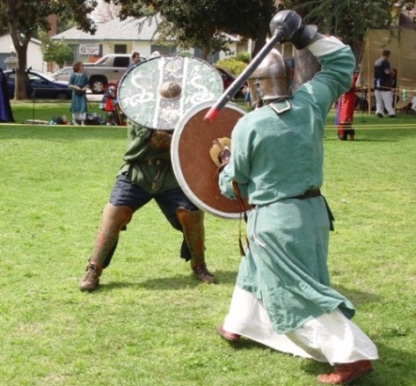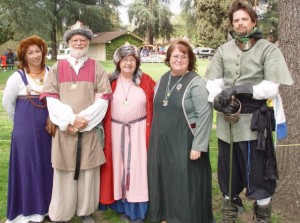
Nothing like a little knight's play to work up a hearty appetite for some peasant stew.
We’ll pardon you if you don’t know this, but La Verne is part of the Heatherwine shire, a name given our city by the Society for Creative Anachronism (SCA). Several of its members camped at Kuns Park on a recent weekend to brew, bake, paint, draw, sing, dance, feast, fight, weave and while away the day in a medieval-style event that tries to remain true to that period of history (600 CE to 1600 CE) when courtesy and chivalry were the twin hallmarks of the age.
They’re not cast-offs from the more locally well-known Renaissance Pleasure Faire (April 14 to May 17 in Irwindale). Their global numbers actually total in the thousands, including about 3,000 members in Southern California, many of whom will be returning to Kuns Park on the Saturday after Thanksgiving. That’s time enough to learn more about this unique organization that began as a backyard celebration in Berkeley, Calif., in the 60s, among friends who enjoyed the history and culture of medieval times.
Struggling to give their casual assembly a name, no less an authority than noted science fiction writer Marion Zimmerman Bradley suggested that the group call itself the Society for Creative Anachronism. They figured they’d change the name later, but 42 years and 50,000 paid members later, the odd name still sticks.
Part of the fun of their world (and yes, they have fun), whether you experience it as a modern (an outsider) or as a member is the language they use. A cell phone is “a fairy in a box,” an airplane is a “dragonfly,” a weekend camp is a “war.” Members have their real names, of course, and their medieval names. To stumble across one of their wars, as I did, is like being thrown into the middle of a movie or a stage play. The events unfolding are exceedingly strange and wonderful at the same time, from watching armed and armored combatants duel inside the list (fighting arena) to taking time out for a bowl of pleasing peasant stew.
One exciting event on their yearly calendar (a SCA group meets somewhere almost every week) is a rat toss, which is not as odious or odiferous as it might seem. Observers throw stuffed toy animals (in this case, rats) at combatants dueling inside the list. If struck, a combatant instantly contracts the plague and is knocked out of the contest. On the Saturday’s encampment that I saw, the contests were a little more toned down — young lieges in search of Easter eggs. The kids also get to fight, but use the dreaded Nerf-style swords.

A merry band of SCAers gather at Kuns Park, from left, Leslie, John, BJo, Gabriela and Greg.
“Our kids are out here with us, participating, instead of watching television,” said Leslie Zaffarana (her real name). She is normally dressed as an Italian woman in garb authentic to the 13th Century, but came this day in Nordic attire. Membership has its privileges.
A student of history, and particularly the Middle Ages, Leslie and other SCA members relish restoring historical accuracy to a largely misunderstood period often referred to as the Dark Ages by the less informed.
“Many of the misconceptions that people have about the Middle Ages,” Leslie said, “have been passed down through the movies. We try to debunk those theories and recreate the Middle Ages as people lived them.” Minus the plague and pestilence, of course!
As an example, Leslie taught that the Vikings are not a people, but a profession of seafarers whose main occupation was empire building through plundering and pillaging. “That’s why you have red heads in the British Isles,” Leslie said. Nordic tribes, I subsequently learned, are the people. (With my new knowledge, I can only imagine how many Scandinavians I’ve offended over the years.).
There is much to learn about this largely forgotten medieval world. Before the SCA returns to La Verne, you should study some basic heraldry, as well as brush up on your aristocratic name calling. When in doubt, just say, “My Lord” or “My Lady.” That tip should spare you from the knight’s cutlass.
Perhaps, the SCA’s greatest appeal is its emphasis on courtly manners and the qualities of loyalty, truthfulness, restraint, generosity, gallantry, grace and brotherhood (sisterhood: was that a medieval term?).
Their real life lessons would be widely welcomed in our courser age, known as the 21st Century.
For more information, visit the SCA’s comprehensive Web site at www.sca.org/.



Leave a Reply